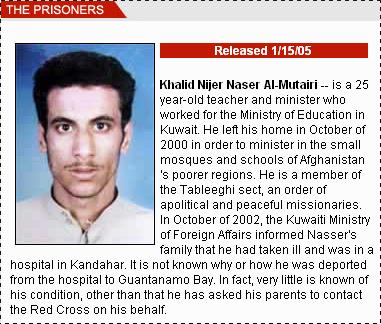Kuwait’s Arab Times reports:
A third Kuwaiti, identified as Bader Al-Harbi has reportedly carried out a suicide attack in Iraq according to knowledgeable sources. The sources told the Arab Times unlike the two other Kuwaitis — Abdullah Al-Ajmi and Nasser Al-Dousari — who are also said to have carried out suicide attacks in Iraq, Al-Harbi was not an ‘inmate’ of the infamous X-Ray Camp in Guantanamo, Cuba [Abdullah Al-Ajmi, aka Abdullah Saleh Ali al-Ajmi, was detained at Guatanamo from 2002 to 2005]. However, he reportedly was in Afghanistan and on his return at the Kuwait International Airport, he was whisked away, imprisoned and released. The sources added when the security authorities felt he was dangerous and tried to arrest him, he gave the securitymen a slip and left for Syria with the two other Kuwaitis from where he left for Iraq and was killed in a suicide attack. Although the details of the operation are sketchy, the sources said Al-Harbi alone drove a bomb laden vehicle while Dousari and Al-Ajmi were reportedly in another car [Ed. — emphasis added mine].
Al-Harbi is believed to be 36 years old and survived by two wives and seven children. The youngest is believed to be just five days old. The sources quoting Al-Harbi’s brother said he left Kuwait about 45 days ago to perform Umra, a minor pilgrimage, in the Kingdom of Saudi Arabia. However, the family later discovered he had left for Syria. The brother added the family received a phone call from an unidentified person who said he was calling from the Islamic State of Iraq. He informed the family that Bader died a martyr in a suicide operation.
Meanwhile the Al-Anba daily said Bader left for Saudi Arabia three weeks ago to perform Umra but he called his family from Syria and sent them a picture posing with Abdullah Al-Ajmi. After his death the family received condolences at their home in Jahra. Mesfer Al-Ajmi, Abdullah’s brother said unidentified persons lured his brother to fight against the US forces in Iraq. He also criticized the State Security police for failing to monitor the activities of the so-called al-Qaeda ‘sleeper cells.’


